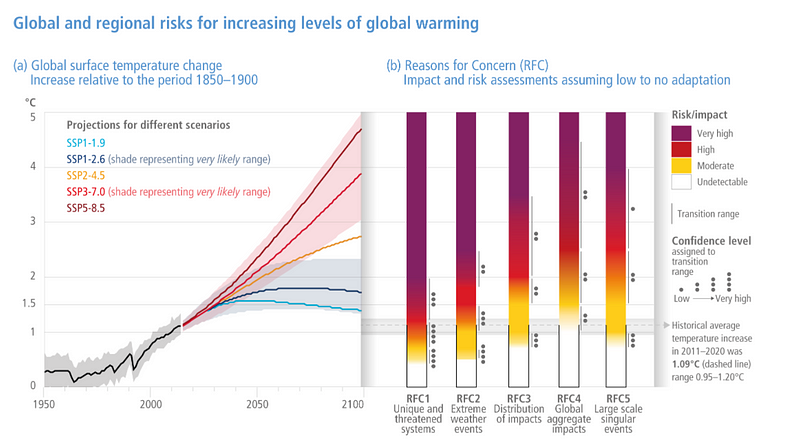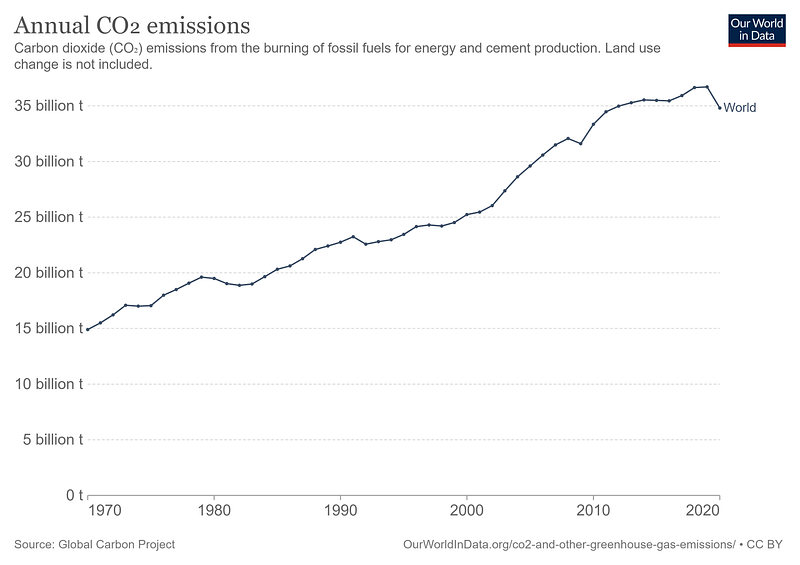Innovative Strategies for Carbon Dioxide Removal and Climate Action
Written on
Chapter 1: Understanding Climate Change and Its Effects
As of 2022, the Earth's average temperature has increased by approximately 1°C (1.8°F) since the onset of the industrial era (1760 — 1840), with the majority of this rise occurring in the last hundred years. Although this change may seem minimal, scientific experts agree that it has already contributed to a higher occurrence of extreme weather phenomena, including heat waves, hurricanes, and wildfires.
The main factor behind global warming is the release of greenhouse gases into the atmosphere, with carbon dioxide (CO₂) being the most significant contributor, alongside methane, nitrous oxide, and other gases. CO₂ is emitted through various human activities and some natural processes, while a portion of it is naturally absorbed through the carbon cycle.
When CO₂ is absorbed by oceans, it leads to increased acidity, which endangers marine life. Since pre-industrial times, oceans have taken in roughly 152 gigatons of CO₂.
Plants, too, absorb CO₂, using carbon atoms to create new cells or produce simple sugars. This process acts as a natural carbon sink, although plants also release carbon when they decompose or are burned.
The Intergovernmental Panel on Climate Change (IPCC) has established that a temperature rise of 2 degrees Celsius is the upper limit for safety. Exceeding this threshold is likely to result in severe adverse effects.

Source: IPCC, 2022: Climate Change 2022: Impacts, Adaptation, and Vulnerability. Contribution of Working Group II to the Sixth Assessment Report of the Intergovernmental Panel on Climate Change.
The figure above illustrates that even at a 1-degree rise, negative impacts are already observable. Each incremental increase brings new obstacles.
The Positive Outlook
Despite the dire assessment, there are feasible paths to limit global warming to 1.5 degrees this century. Achieving this goal would maximize opportunities to enhance climate resilience and fulfill global sustainable development objectives.
However, to restrict warming to 1.5 degrees, the IPCC report emphasizes the necessity of developing and deploying carbon dioxide removal (CDR) technologies. Merely halting emissions is insufficient; we must also initiate the process of removing previously emitted carbon.
The encouraging news is that global CO₂ emissions have stabilized and remained relatively constant over the past decade. Except for China and India, emissions worldwide are on a downward trend.

Source: Hannah Ritchie, Max Roser, and Pablo Rosado (2020) — “CO₂ and Greenhouse Gas Emissions”. Published online at OurWorldInData.org.
Governments, responding to growing public pressure, are setting ambitious emission reduction targets, transitioning from internal combustion engine vehicles, investing in renewable energy, and striving for net-zero emissions by 2050.
The year 2022 marked a pivotal moment in climate finance with the launch of Frontier, a commitment to purchase nearly $1 billion in permanent carbon removal between 2022 and 2030. This initiative is backed by companies like Stripe, Alphabet, Shopify, and Meta, along with numerous small businesses.
Simultaneously, climate technology startups are securing substantial venture capital to combat climate change. The rationale for investor interest is clear: the carbon removal market is estimated to be worth $6 trillion. Innovative technologies can transform carbon dioxide from a waste product into valuable resources like fuels, chemicals, and building materials.
The emergence of carbon technologies presents a unique opportunity to profit while addressing environmental issues. This unprecedented alignment of incentives marks a significant moment in capitalism.
The XPRIZE Carbon Removal competition offers a prize pool of $100 million for companies demonstrating scalable innovations with durable carbon storage lasting at least 100 years. Recently, the top 15 firms received $1 million milestone prizes, with final winners to be announced in 2025.
This video discusses technological solutions for achieving negative emissions and carbon dioxide removal, highlighting innovative methods being implemented today.
Technological Innovations for Climate Mitigation
To keep global warming within the 1.5-degree target, it is crucial to swiftly reduce reliance on fossil fuels and implement technologies capable of permanently removing carbon dioxide.
The following section delves into various innovative approaches that are emerging in this field.

Source: Frontier. Historical Emissions via Global Carbon Project, “Current path” shows SSP4–6.0, removal pathways adapted from CICERO.
Carbon Capture and Sequestration (CCS)
Certain industries, such as cement and steel production, are particularly challenging to decarbonize, contributing 8% and 9% of total carbon emissions, respectively. Natural gas peaker plants will likely remain essential for grid stability as renewable energy sources expand.
In the fertilizer sector, hydrogen is a crucial input, predominantly produced through methane reforming, a process that emits CO₂. For the foreseeable future, humanity will likely continue relying on these sectors until zero-carbon alternatives can be developed. To offset their emissions, waste gases can be funneled into carbon capture devices that isolate pollutants, which can then be permanently stored underground in geological formations.
However, CCS increases operational costs for these industries, and without regulatory frameworks or a strong carbon market, companies may be reluctant to invest in retrofits. Aker Carbon Capture is one example of a company striving to make CCS more affordable and scalable.
Direct Air Capture (DAC)
In contrast to CCS, which captures carbon from concentrated sources, direct air capture aims to extract CO₂ directly from the atmosphere. Currently, atmospheric CO₂ concentration stands at about 415 parts per million (ppm), a significant rise from approximately 278 ppm before the industrial era.
DAC seeks to mimic the function of trees, achieving carbon capture at a much quicker rate and requiring less land. These facilities can be established globally and powered by renewable energy sources. Common DAC techniques involve passing ambient air through filters that trap CO₂ molecules. One method employs a solution of calcium hydroxide, which reacts with CO₂ to form stable calcium carbonate (limestone) for long-term carbon storage.
Numerous startups are entering this space, with some capable of capturing kilotons of CO₂ annually, and several more aiming to exceed 1 megaton. The current cost of capturing carbon is relatively high, ranging from $200 to $600 per ton, but ongoing advancements in energy efficiency and chemical processes are expected to lower costs to around $100 per ton.
Key players in this field include Climeworks, Carbon Engineering, Sustaera, and many others. An essential technology for permanent sequestration is Carbfix, which enables the injection of dissolved CO₂ into deep rock formations, where the carbon solidifies over time.

Photo by Lubo Minar on Unsplash.
Enhanced Weathering and Mineralization
Enhanced weathering aims to speed up the Earth's natural carbon cycle. Rocks and minerals that come into contact with air and water react with CO₂ to form stable carbonates. This process, known as mineralization, has a significant impact when it occurs in oceans, as the carbonates eventually sink to the seabed.
Oceans act as a vital carbon sink, absorbing most of the CO₂ released into the atmosphere, helping to mitigate global warming. However, this has consequences, such as increasing ocean acidity, which threatens marine life that relies on calcium for shell formation. Accelerating mineralization can help balance ocean pH levels.
Some companies are grinding minerals like basalt into fine particles that can be distributed along coastlines or forest floors, where they can react with water and air. This method is not only cost-effective but also has the potential to enhance soil quality. When implemented in oceans, it can further alleviate acidity. Nonetheless, questions linger about the amount of carbon that can be effectively removed and the potential environmental impacts of mineral extraction.
Companies involved in enhanced weathering include Project Vesta, Patch, Carbfix, and others.

Photo by Artiom Vallat on Unsplash.
Biofuels and Bioenergy with Carbon Capture and Storage (BECCS)
Hydrocarbons used for fuel originally stem from ancient vegetation that has undergone transformation into coal or oil. This implies that it is feasible to convert harvested plant material into energy-dense fuels through appropriate chemical processes. Since plants absorb CO₂ as they grow, these fuels could theoretically achieve net-zero emissions. The combination of bioenergy (BE) with carbon capture and sequestration (CCS) results in BECCS.
This technology is already in use in various forms. For instance, in some regions, diesel fuel is blended with vegetable oil to lower its carbon footprint. Gasoline can be mixed with ethanol, and sustainable aviation fuel (SAF) serves as a fully biological alternative to traditional jet fuel. When burned, SAF releases carbon that was previously absorbed by the plants used to produce it, resulting in minimal net emissions.
However, challenges remain, such as the higher costs associated with biofuels compared to fossil fuels, making market establishment challenging. Additionally, if crops for biofuels displace food crops, this could lead to increased food prices and food insecurity, potentially prompting further deforestation.
Fortunately, companies like Charm Industrial are addressing these issues by producing bio-oil from agricultural waste and other biomass that can be cultivated on non-arable land. This process can also facilitate pure carbon sequestration if the resulting bio-oil is injected into porous rock formations.
Organizations engaged in BECCS and related initiatives include Charm Industrial, the Bioeconomy Institute Carbon Removal Team at Iowa State University, and several others.

Photo by Irina Iriser on Unsplash.
Natural Approaches to Carbon Removal
This article has primarily focused on technological strategies for carbon removal. However, it is vital not to overlook nature-based solutions, such as land use changes and reforestation, which hold significant potential for carbon capture, enhancing biodiversity, and reducing emissions.
None of the technical solutions discussed are panaceas. Each comes with its own set of costs, scalability challenges, and potential side effects, a reality that also applies to many nature-based approaches.
For example, while tree planting is often heralded as a straightforward climate solution, trees only sequester carbon over short timescales, and a single wildfire can erase years of carbon capture. Additionally, identifying suitable areas for large-scale tree planting can reduce land availability for agriculture. Afforestation can disrupt existing ecosystems and alter the Earth’s reflectivity, contributing to further warming.
Nature-based solutions for carbon removal merit their own dedicated exploration and are an integral aspect of the broader strategy. To achieve net-zero emissions by the mid-century and stabilize the climate by the century's end, the world must pursue a combination of natural and technological methods for carbon removal. Each approach requires careful evaluation and implementation.

Photo by Timothy K on Unsplash.
This video explains various negative emission technologies, providing insights into how they work and their significance in addressing climate change.